- Home
- Terry Pratchett
Turtle Recall: The Discworld Companion ... So Far Page 13
Turtle Recall: The Discworld Companion ... So Far Read online
Page 13
Despite rumour, he is not cruel. He is just terribly, terribly good at his job. It is said that he doesn’t get angry, because anger is an emotion, and for emotion you need glands; however, he does seem to be capable of a piece of intellectual disapproval which has a very similar effect. He is a traditionalist who prides himself on his personal service, and, despite the absence of glands, can become depressed when this is not appreciated.
Humanity intrigues Death. He is particularly fascinated by mankind’s ability to complicate an existence which, from Death’s point of view, is momentary. He appears to spend a lot of time trying to learn, by logical deduction, the things that humanity takes for granted. In the process, he seems to have developed what can only be called preferences and likings – for cats, for example, and curry. He has tried to take up the banjo, but lacks any skill with such a living thing as music.
Death has a property not locatable on any normal atlas, on which he has called into being a house and garden. There are no colours there except black, white and shades of grey; Death could use others but fails to see their significance. And, because he almost by definition lacks true creative ability – he can only copy what he has seen – no real time passes in his domain. Nor do things live or grow in the normal sense, unless they are brought in from outside, but they exist in an apparently unchanging, healthy state.
He appears to derive his opinion of how he should live by observing people, but the nuances consistently escape him. He has a bedroom, for example, because although Death never sleeps, it’s right that houses have bedrooms. He also has a bathroom, although the ablutionary fixtures were supplied by a plumber from Ankh-Morpork because plumbing is among those activities where Death’s constructive abilities find themselves cramped; he was not aware that pipes were hollow inside, for example. On his dressing table he has a pair of silver-backed hairbrushes and a little glass tray for cufflinks, despite having neither hair nor cuffs. He thinks that’s what he ought to have.
As with all creatures that have existence, Death has an hourglass/lifetimer that measures the length of his days. His is several times the size of normal people’s glasses, and is black, thin and decorated with a complicated skull-and-bones motif. It has no sand in it.
There is a strong suggestion in the books that Death is somehow on our side, which is borne out by events in Thief of Time and Reaper Man.
Death and being dead. From the point of view of the recently dead, the world suddenly looks at one and the same time very complicated and very simple.
It is complicated because, while death frees the mind from the strait-jacket of three dimensions, it also cuts it away from TIME, which is only another dimension. So a cat can be seen as a tiny kitten and a fat, half-blind old moggy and every stage in between. All at once. Since it will have started off small it will look like a white, cat-shaped carrot – a description that will have to do until people invent proper four-dimensional adjectives (generally, however, the dead stick to normal temporal perception by force of habit, one of the strongest forces in the universe).
It is simple, on the other hand, because the self-delusion that attends the living is immediately stripped away. The dead see the world as real for the first time.
There appears on Discworld, as everywhere else, to be no general consensus about the afterlife. Some religions believe that the dead must journey across a vast empty desert, or sea, or range of metaphorical mountains, in order to receive some kind of judgement at the end. There are various heavens and hells, and it appears that the soul’s ultimate destination is that place where its owner, shorn by death of all self-deception, believes he or she ought to go. Which suggests that they won’t go to any kind of hell if they don’t know about it, a depressing thought that should call for the instant cessation of all missionary activity.
Basically, everyone gets what they think is coming to them. This does not seem fair, but then no one ever said it would be.
d’Eath, Edward. The thirty-seventh Lord d’Eath. A trained and qualified assassin who was also the first person ever to pass the post-graduate course with full marks. Although the family were at one time very rich, the money was frittered away and Edward, dreaming of better days, was forced into cramped lodgings in Kingsway in Ankh-Morpork. As sometimes happens with people who don’t mix with other humans often enough to have their mental clocks reset to ‘sanity’, he developed strange notions and became obsessed with Ankh-Morpork’s royal heritage and its noble past, i.e. the time when the d’Eaths had money and power. He very foolishly set in motion the events of Men At Arms and shortly afterwards met his death (no relation). [MAA]
Death, House of. The Farewell Tour.
The land on which DEATH’S house rests floats in space. It can only be described as raw surface. Seen edge on, it has no apparent thickness. When walked on it appears quite solid. To get to the house we walk across the black moors, through a gate and up a little path leading to a small black house, backed by an extensive garden. Deep in the garden is an apparently bottomless pit, through which souls travel to their next destination. There are extensive areas of topiary and an ornamental fish pond. In keeping with Death’s erratic approach to matters of taste, there are also cheery little skeletal garden gnomes.
There is a bird table. One may speculate upon the nature of the birds.
There is an orchard, where black apple trees grow black fruit. Among the trees are Death’s beehives; the bees are big, black and slow in their movements, storing glistening black honey in pure white combs. It’s anyone’s guess what it tastes like, or what would happen to any living person who ate it.
On the front lawn is a sundial. It has no gnomon, because no time passes here (see below) and in any case there is no sun. The sky is night-black, with visible stars, although the landscape is quite brilliantly illuminated.
The back garden contains a large vegetable patch. Real plants grow here, from real seeds brought from the World and fed with compost derived from the stables. There is a tendency, however, for all the plants to be black. It may be that at some genetic level they enter into the spirit of the thing. Surrounding the garden are rolling fields of corn, making a strange golden splash of colour in the otherwise sombre landscape. Elsewhere, within the house as well as in the garden, there is no colour other than that which has been imported from the World by the human occupants.
To one side of the house, as we enter, is the courtyard leading to the stable block, from which a stone-flagged passageway leads into the main hall of the house. We, however, are going to use the front door.
Notice the mat with ‘Welcome’ on it. The hall beyond is obviously much bigger than the whole house appears to be from the outside. This is Death’s domain; dimensions are entirely arbitrary and the size of rooms depends upon the degree of perception of the observer.
For example, this is Death’s observation of his servant ALBERT bringing him a cup of tea:
Albert approached very carefully.
It had continually puzzled Death in his more introspective moments, and this was one of them, why his servant always walked the same path across the floor.
I MEAN, he thought, CONSIDER THE SIZE OF THE ROOM . . .
. . . which went on to infinity, or as near infinity as makes no difference. In fact it was about a mile. That’s big for a room, whereas infinity you can hardly see.
Death had got rather flustered when he’d created the house. Time and space were things to be manipulated, not obeyed. The internal dimensions had been a little too generous. He’d forgotten to make the outside bigger than the inside. It was the same with the garden. When he’d begun to take a little more interest in these things he’d realised the role people seemed to think that colour played in concepts like, for example, roses. But he’d made them black. He liked black. It went with anything. It went with everything, sooner or later.
The humans he’d known – and there had been a few – had responded to the impossible size of the rooms in a strange way, by simply ignorin
g them.
Take Albert, now. The big door had opened, Albert had stepped through, carefully balancing a cup and saucer . . .
. . . and a moment later had been well inside the room, on the edge of the relatively small square of carpet that surrounded Death’s desk. Death gave up wondering how Albert covered the intervening space when it dawned on him that, to his servant, there was no intervening space . . .
At this point it should be added that, since all dimensions here have a certain subjective element, so also does the dimension of TIME. No time passes in the real sense. But something passes; a dropped cup will hit the floor and break, so there must be some ‘time’ in which this can happen and some framework in which the cup is now broken but was once whole. What there appears to be, in fact, is a sort of subjective recirculating time, very similar to that experienced in DJELIBEYBI owing to the temporal braking power of its many pyramids. It is as though, instead of proceeding in a straight line like a train, time spins gently in a circle like a carousel; people can talk and move about and even appear to travel, while in fact never actually going anywhere.
The hall is illuminated by tall, narrow windows, is full of doors and is decorated with a lot of funereal drapes. The arched doorways are decorated with a skull-and-bones motif. To one side is an umbrella stand with a scythe in it. The floor is covered with black and white tiles.
Ahead of us are two curved wooden staircases, leading to a bare wooden corridor lined with yellow candles set in holders in the walls. This leads to the private area of the house – the bedrooms and other facilities. The staircases are covered with strange and disturbing carvings, which do not bear close examination, possibly because they are horrible but more probably because of general tastelessness. (No one on the Disc has yet sold paintings on black velvet, or pictures of jolly dogs sitting at the table having dinner, but if they did, and if by chance they sold them at Death’s door, he would certainly buy several copies. Death, as has been intimated elsewhere, has no artistic taste. It is not simply that he cannot see the difference between, say, the Mona Ogg and a set of three plaster flying ducks – for him there is no difference. In fact, he would probably prefer the ducks, which are more cheerful. He likes a bit of life around the place.)
Occupying the space between the staircases is a large grandfather clock. Two things about the clock are worthy of notice: first, it has a very long pendulum, with a knife-edged and very sharp weight. Second, the clock has no hands because there is, strictly speaking, nothing here for it to measure.
Then there is the passageway leading to the stables. Another one leads eventually to Death’s study. In real terms his study is probably more than a mile across, with shadows of what might be wheels and strange machinery in its distant recesses. The rest of the furniture, out of deference to the house’s human occupants, is grouped on a square of carpet in what has to be called the ‘conceptual’ room.
Large hourglasses cover every flat surface – work in progress, as it were. There are also a lot of fat, yellow and runny candles. Apart from the imposing and ornate desk and large, leather swivel-chair, the room also contains bookcases, more shelves of hourglasses, a large lectern with a map on it and a black baize card table. In one corner and dominating the room, however, is a large disc of the world. This magnificent feature is complete down to solid silver elephants standing on the back of a Great A’TUIN cast in bronze and more than a metre long. The rivers are picked out in veins of jade, the deserts are powdered diamonds and the most notable cities are picked out in precious stones.
On the scarred woodwork of the desk is a large ledger, an abacus, an inkwell and pen, a scythe-shaped paper knife and a coffee mug – ‘To The World’s Greatest Granddad’, with a picture of a teddy bear. There is also what can only be called an executive toy (you swing one ball against a small lead slab, where it stops). As we turn to leave the room we note the sword, Death’s other working tool, in the rack by the door.
We turn left into the corridor and unlock the door into the long lifetimer room.
This tiled room is vast by any or all standards. In here are serried rows of hourglasses of all manner of designs, stretching away into the distance on row after row of shelves. Here and there the shelves are divided by stone pillars inscribed with angular markings. We can’t show you this, but part of the shelving swings out to reveal a smaller room (about the size of a cathedral) which contains the lifetimers of the gods and of anthropomorphic personifications. The sound in the lifetimer room, of hissing sand, is deafening (but the discerning may hear the ‘pop’ and ‘ping’ as empty hourglasses vanish and new, full ones reappear elsewhere).
Leaving the roaring sand behind us we return to the main hallway and find, through another door, the extensive library of the house. As we open the door with its protesting creak (there is no rust; Death knows that some doors should creak) a gust of warm air drifts out. Entering the book-lined room, one is struck immediately by the sound of subdued scratching, as of a room full of clerks all writing away with quill pens. This is the library of the autobiographies – each book writing itself as its subject drifts through their life.
Lighting a candle to supplement the light from the high windows and with considerable effort moving aside the huge pedal-driven library ladder, we come to a little alcove and pass through another door which leads us down stone steps into the velvet gloom of the stack. In this vast space are stored biographies more than five hundred years old. The room is as dark and silent as a cave deep underground. The shelves are barely far enough apart for one person to walk between them and they tower up well beyond the dome of our candlelight. The dusty floor records our footprints.
Everyone who ever lived and died is recorded here. Go far enough through the book-lined darkness and the books become scrolls, the scrolls become wax tablets, the tablets become mere scratchy stones.
And now our tour takes us back, through the entrance hall and down a few steps into the kitchen. Again, this is a smaller room within a great black cavern, but the little square of light suggests a low, warm room, with copper pans hanging from the non-existent ceiling and a vast black iron stove – a Little Moloch, almost certainly imported from Ankh-Morpork – along the whole of one wall (or edge). In the centre of the floor is a white scrubbed table and some chairs. On another wall is a set of bells connecting with the rest of the house.
One of them jangles.
That’s the back door over there. I should use it quickly, if I were you . . .
Death, New. A hooded figure, carrying a scythe and riding a burning skeletal steed. Taller even than DEATH himself, he had no face – smoke curled formlessly between the top of his robe and a golden crown. Called into existence as a result of Death’s temporary retirement, and lacking any of the empathy resulting from thousands of years of close personal contact with humanity. [RM]
Death of Rats. About six inches high, the Death of Rats wears a black robe and holds a small scythe in one skeletal paw or, when he needs to hurry and wants to use all four legs, his mouth. He has a bone-white nose with brittle grey whiskers protruding from its shadowy hood. As his name suggests, he specialises in rats but also does gerbils, mice and hamsters if it is DEATH’S busy time. In a sense he is a sub-Death, and it appears in the books that DEATH allows him to show those traits, like humour and mischievousness, that Death himself could not decently employ.
Death’s Glory. Dry fly invented by DEATH when he was looking for ways of having Fun. He’d heard that fishing was fun. In fact fishing is like being dead, but with the additional disadvantage of being alive to experience it. [M]
Dee. A dwarf of the old school. The Low King’s jar’ahk’haga, or ideas taster – a sort of personal assistant cum political adviser. Dee wore robes of thick overlapping leather plates and a pointed leather hat with more leather flaps around it – the one at the front being tied up to allow him to look out at the world. Dee was involved in some intrigue relating to the coronation of the Low King. [TFE]
Dee,
John. Roundworld astrologer to Mary Tudor and Elizabeth I, encountered by UU’s wizards during the events of The Science of Discworld 2. He never quite got over it. [TSOD2]
Dehydrated Ocean. Sited at the heart of the Great NEF. Water on the Disc has an uncommon fourth state, caused by intense heat combined with the strange desiccating effects of OCTARINE light; it dehydrates, leaving a silvery residue like free-flowing sand through which a well-designed hull can glide with ease. Said to have very strange fish. Dehydrated water can easily be reconstituted by adding water. [COM]
Deities and supernatural beings. There are 3,000 known major gods on the Disc, and more are discovered by research theologians every week.
It is quite probable that some deities feature under many different names. In fact many gods, by means of false noses and other props, can appear in religious chronicles under anything up to a hundred different names and descriptions.
Since belief is the true life force of the gods, this is a good way of getting as much of it as they can – rather like working in a fast-food joint or running a mini-cab in your spare time, although it is more on the level of fraudulently claiming a thousand different Social Security Giros by means of forged IDs.
It seems likely that this is particularly prevalent in DJELIBEYBI, where the plethora of gods with short explosive names, like Nat, Wat and Zak, suggests a particularly profitable scam by someone with a dictionary and little imagination.
Known gods and ‘god-like entities’ (i.e., not human, but immensely powerful, capricious, self centred and generally amoral beings; unfortunately, this definition includes most monsters and demons as well, but there you go) include:
Alohura, Goddess of Lightning (beTrobi) [COM]
Aninger, Goddess of Squashed Animals [TLH]
ANOIA [MR, GP, UA]
Astoria, Goddess of Love (Ephebe) [SG]

 Feet of Clay
Feet of Clay The Color of Magic
The Color of Magic Thud!
Thud! Good Omens: The Nice and Accurate Prophecies of Agnes Nutter, Witch
Good Omens: The Nice and Accurate Prophecies of Agnes Nutter, Witch I Shall Wear Midnight
I Shall Wear Midnight Mort
Mort Raising Steam
Raising Steam Guards! Guards!
Guards! Guards!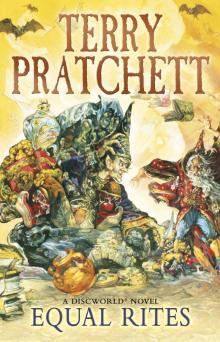 Equal Rites
Equal Rites A Hat Full of Sky
A Hat Full of Sky The Light Fantastic
The Light Fantastic Mrs Bradshaw's Handbook
Mrs Bradshaw's Handbook Wyrd Sisters
Wyrd Sisters Soul Music
Soul Music Small Gods
Small Gods Sourcery
Sourcery Reaper Man
Reaper Man Night Watch
Night Watch Lords and Ladies
Lords and Ladies The Fifth Elephant
The Fifth Elephant Monstrous Regiment
Monstrous Regiment The Truth
The Truth Witches Abroad
Witches Abroad Eric
Eric Going Postal
Going Postal Men at Arms
Men at Arms Jingo
Jingo The Amazing Maurice and His Educated Rodents
The Amazing Maurice and His Educated Rodents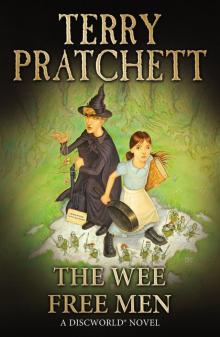 The Wee Free Men
The Wee Free Men Pyramids
Pyramids Wintersmith
Wintersmith Moving Pictures
Moving Pictures Carpe Jugulum
Carpe Jugulum Interesting Times
Interesting Times Maskerade
Maskerade Making Money
Making Money The Shepherd's Crown
The Shepherd's Crown Hogfather
Hogfather Troll Bridge
Troll Bridge The Last Continent
The Last Continent The Sea and Little Fishes
The Sea and Little Fishes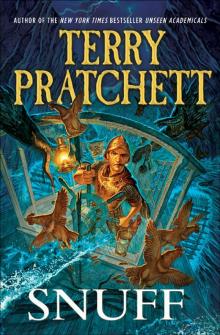 Snuff
Snuff Unseen Academicals
Unseen Academicals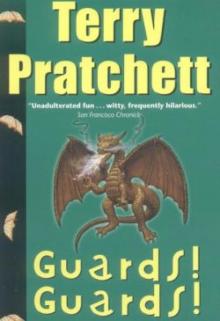 Guards! Guards! tds-8
Guards! Guards! tds-8 Jingo d-21
Jingo d-21 Turtle Recall: The Discworld Companion ... So Far
Turtle Recall: The Discworld Companion ... So Far The Fifth Elephant d-24
The Fifth Elephant d-24 Discworld 39 - Snuff
Discworld 39 - Snuff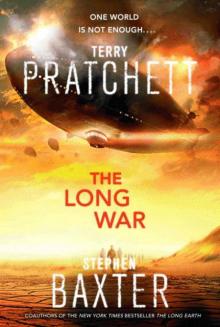 The Long War
The Long War Only You Can Save Mankind
Only You Can Save Mankind The Science of Discworld III - Darwin's Watch tsod-3
The Science of Discworld III - Darwin's Watch tsod-3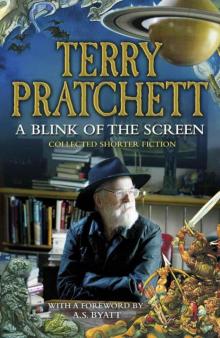 A Blink of the Screen: Collected Short Fiction
A Blink of the Screen: Collected Short Fiction Unseen Academicals d-37
Unseen Academicals d-37 Wings
Wings Making Money d-36
Making Money d-36 A Blink of the Screen
A Blink of the Screen Johnny and the Bomb
Johnny and the Bomb Dodger
Dodger Strata
Strata Discworld 02 - The Light Fantastic
Discworld 02 - The Light Fantastic The Folklore of Discworld
The Folklore of Discworld The Science of Discworld
The Science of Discworld The Unadulterated Cat
The Unadulterated Cat Raising Steam: (Discworld novel 40) (Discworld Novels)
Raising Steam: (Discworld novel 40) (Discworld Novels) The World of Poo
The World of Poo Discworld 05 - Sourcery
Discworld 05 - Sourcery The Witch's Vacuum Cleaner: And Other Stories
The Witch's Vacuum Cleaner: And Other Stories The Science of Discworld II - The Globe tsod-2
The Science of Discworld II - The Globe tsod-2 Small Gods: Discworld Novel, A
Small Gods: Discworld Novel, A Men at Arms tds-15
Men at Arms tds-15 Tama Princes of Mercury
Tama Princes of Mercury The Last Hero (the discworld series)
The Last Hero (the discworld series) The Long Utopia
The Long Utopia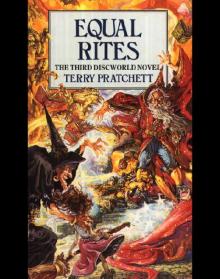 Discworld 03 - Equal Rites
Discworld 03 - Equal Rites Terry Pratchett - The Science of Discworld
Terry Pratchett - The Science of Discworld The Long Earth
The Long Earth The Carpet People
The Carpet People The Sea and Little Fishes (discworld)
The Sea and Little Fishes (discworld)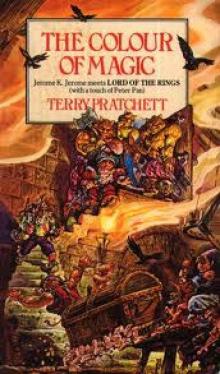 The Colour of Magic
The Colour of Magic Discworld 16 - Soul Music
Discworld 16 - Soul Music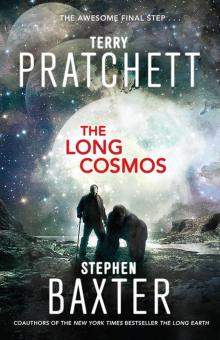 The Long Cosmos
The Long Cosmos The Dark Side of the Sun
The Dark Side of the Sun Monstrous Regiment tds-28
Monstrous Regiment tds-28 The Bromeliad 3 - Wings
The Bromeliad 3 - Wings Dragons at Crumbling Castle: And Other Stories
Dragons at Crumbling Castle: And Other Stories Night Watch tds-27
Night Watch tds-27 The Science of Discworld I tsod-1
The Science of Discworld I tsod-1 The Bromeliad 1 - Truckers
The Bromeliad 1 - Truckers The Science of Discworld Revised Edition
The Science of Discworld Revised Edition The Abominable Snowman
The Abominable Snowman Father Christmas’s Fake Beard
Father Christmas’s Fake Beard The Bromeliad Trilogy
The Bromeliad Trilogy A Slip of the Keyboard
A Slip of the Keyboard The Wee Free Men d(-2
The Wee Free Men d(-2 Johnny and the Dead
Johnny and the Dead Mrs Bradshaw's Handbook (Discworld Novels)
Mrs Bradshaw's Handbook (Discworld Novels) Truckers
Truckers The Amazing Maurice and His Educated Rodents d(-1
The Amazing Maurice and His Educated Rodents d(-1 Diggers
Diggers Thief of Time tds-26
Thief of Time tds-26 Science of Discworld III
Science of Discworld III Dragons at Crumbling Castle
Dragons at Crumbling Castle Nation
Nation Darwin's Watch
Darwin's Watch Interesting Times d-17
Interesting Times d-17 The Bromeliad 2 - Diggers
The Bromeliad 2 - Diggers The Science of Discworld II
The Science of Discworld II